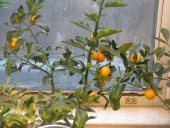
 3
3








 1
1
















“Enough is as good as a feast"
-Mary Poppins




bit.ly/CommunityEcosystem
Making fresh food affordable by growing artists and entrepreneurs.
 2
2









Works at a residential alternative high school in the Himalayas SECMOL.org . "Back home" is Cape Cod, E Coast USA.
 1
1




High quality probiotic cultures specializing in kombucha cultures and water kefir grains that grow like gangbusters. Check out the March special how to get free water kefir grains. Kefirlady.com








D. Klaer wrote:
Yellow sapote - Growing well, yet to flower




Heather Davis wrote:
D. Klaer wrote:
Yellow sapote - Growing well, yet to flower
How did you sprout the sapote seeds? Are yellow sapotes the same as white sapotes? I have started Loquat, Cherimoyas and Papaya from seed by wrapping them in damp paper towels and putting them in a plastic bag "greenhouse" unit they sprouted, but the white sapote seeds kept molding and not germinating. I planted 6 white sapote seeds in planters next to other plants and hope they germinate, but nothing yet and it's been about 3 weeks. I collected some Carob pods and plan on making carob powder, trying to ferment the carob since it's very sweet and also planting the seeds. Moringa is on my list as well, although I'll harvest the leaves and keep them too short to fruit.
I have figs trees that I started from cuttings and am going to try air rooting my friend's passion fruit. Next season, I want to try sprouting guavas, too. I don't have any room to grow trees, but give them away or keep them in planters. My goal is no cost gardening / food forest, although I'll buy seeds. I borrow my friend's yards and community garden plots. If I had my own land, I think I'd be willing to spend some money, but I'm having fun learning how to be resourceful!









 1
1




Seeking a long-term partner to establish forest garden. Keen to find that person and happy to just make some friends. http://www.permies.com/t/50938/singles/Male-Edinburgh-Scotland-seeks-soulmate
 2
2





|
I child proofed my house but they still get in. Distract them with this tiny ad:
The new purple deck of permaculture playing cards
https://www.kickstarter.com/projects/paulwheaton/garden-cards
|







